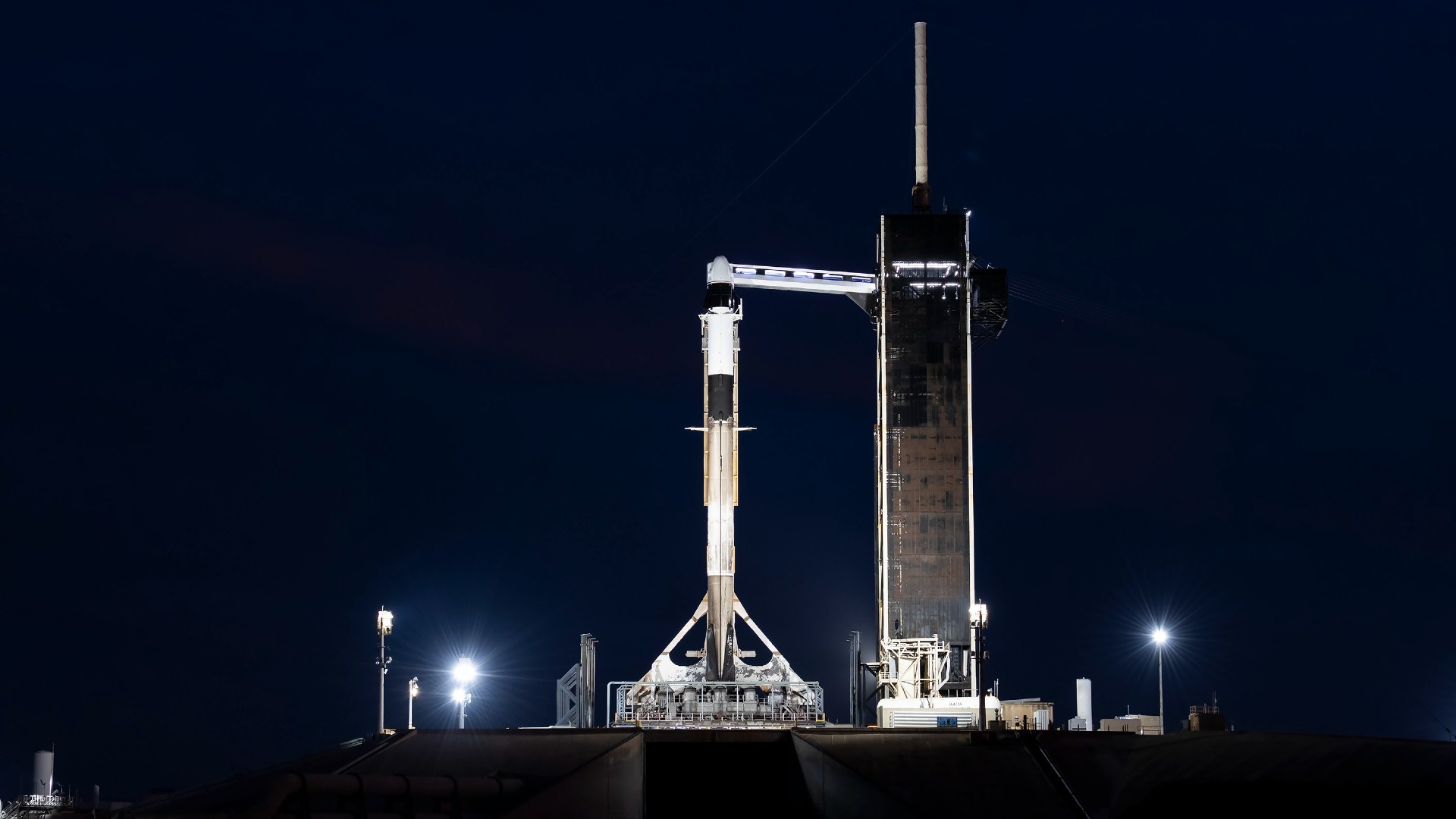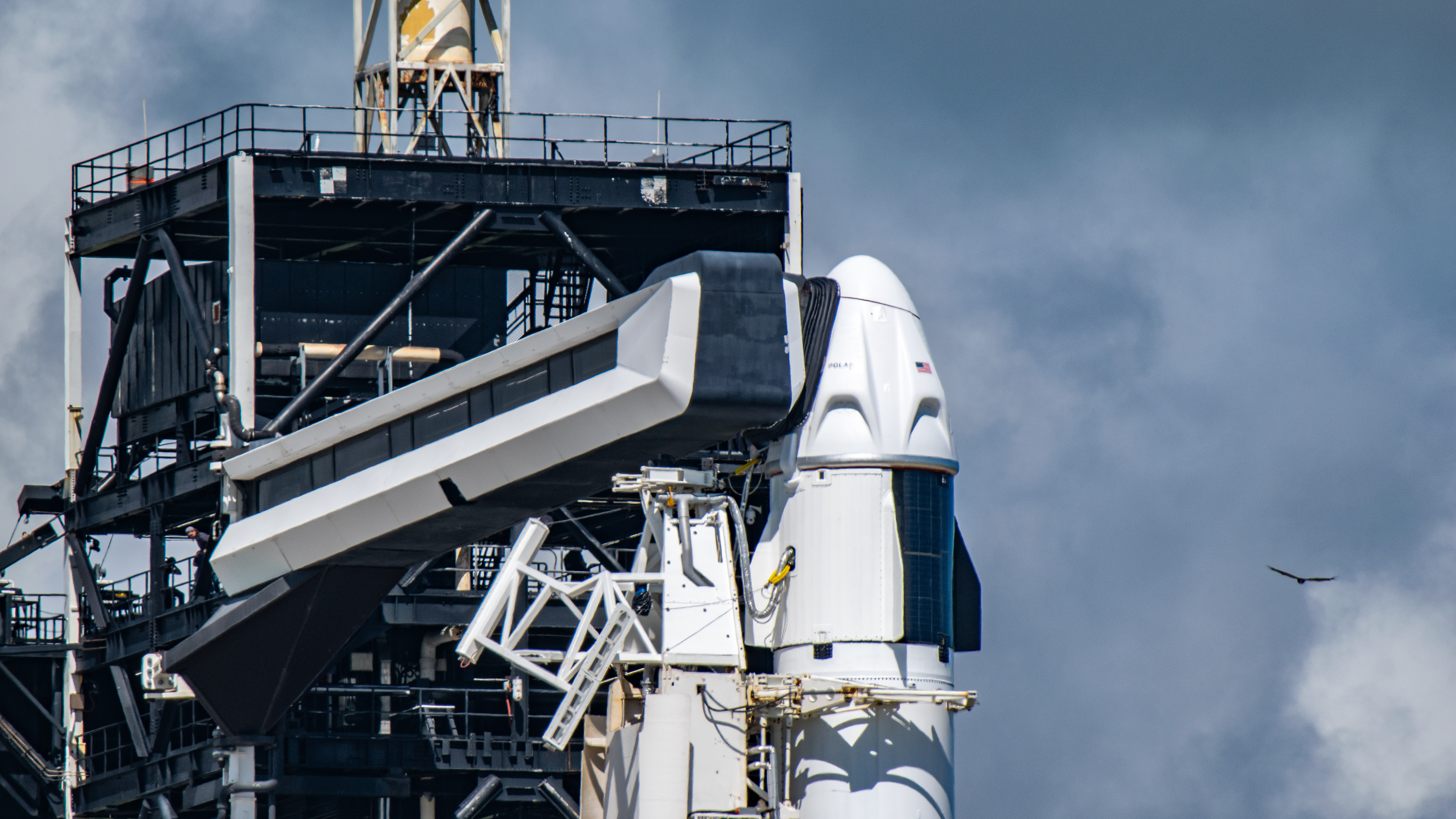SpaceX to launch private Polaris Dawn spacewalk mission overnight on farthest human spaceflight since Apollo
Over half a century has passed since humans flew this far from Earth.

Update for Sept. 9: This piece was updated to reflect the most current launch opportunities announced by SpaceX.
CAPE CANAVERAL, Fla. — SpaceX is about to launch four private astronauts farther than any human has flown since the end of the Apollo era. The crew will be on a mission to perform history's first commercial spacewalk.
The mission, Polaris Dawn, will liftoff early Tuesday (Sept. 10) during a four-hour launch window that opens at at 3:38 a.m. ET (0738 GMT). Two additional launch opportunities are available within the four-hour window; one at 5:23 a.m. ET (0923 GMT) and another at 7:09 a.m. ET (1109 GMT). Backup launch opportunities are available on Wednesday (Sept. 11) at the same times, according to SpaceX.
"Targeting no earlier than Tuesday, Sept. 10 for Falcon 9's launch of the Polaris Dawn mission," SpaceX wrote in a post on X (formerly Twitter) on Sept. 8. "Weather is currently 40% favorable for liftoff, and conditions at the possible splashdown sites for Dragon's return to Earth remain a watch item." To watch the launch live, you can tune into Space.com or SpaceX's webcast on X, starting about 3.5 hours before liftoff.
Polaris Dawn will liftoff from SpaceX's Launch Complex-39A at NASA's Kennedy Space Center — the same pad that supported all the crewed Apollo missions to the moon. Though it's true each of SpaceX's astronaut launches to date has flown out of LC-39A, it's particularly fitting that the members of Polaris Dawn will also launch from there, as this mission will take them further than any crewed flight has gone since Apollo 17, in 1972.
Billionaire philanthropist Jared Isaacman is footing the bill for the mission, and intends it to be the first of three in his "Polaris Program." Dawn will be the second space mission Isaacman has funded, as well as his second personal launch to orbit. His first in both cases came in 2021, with the launch of Inspriation4 — the first all-civilian spaceflight. These missions, and the next two planned for the Polaris Program, are being flown with the dual goal of furthering the bounds of private human space exploration and raising money to support St. Jude Children's Research Hospital. With Inspriation4, Isaacman and the mission were able to raise $250 million in donations for the organization.
Isaacman will fly as Polaris Dawn's mission commander, and will be joined by the mission's pilot, retired United States Air Force (USAF) Lieutenant Colonel Scott "Kidd" Poteet, and the first two SpaceX employees to launch to orbit, Sarah Gillis and Anna Menon, who both work as Lead Space Operations Engineers. Gillis and Menon will serve as mission specialists.
Get the Space.com Newsletter
Breaking space news, the latest updates on rocket launches, skywatching events and more!
The crewmembers will launch aboard a SpaceX Crew Dragon capsule into an elliptical orbit, flying to an initial maximum altitude (apogee) of about 745 miles (1,200 kilometers), where they will spend the beginning of their first day in space. After several orbits, Dragon will raise its apogee about 125 miles, to a maximum altitude of 870 miles (1,400 kilometers). At this distance from Earth, Polaris Dawn will fly through a portion of the radiation belts wrapped around our planet beyond its lower orbits. Taking advantage of this course, the crew plans to complete a number of science experiments to study the deep-space radiation environment.

The trajectory also reaches another significant milestone for human spaceflight. Menon and Gillis will become the highest-flown women in history during this mission, beating out the previous altitude record set by NASA astronaut Kathryn Sullivan. They will fly several hundred miles higher than Sullivan, who reached an altitude of 386 miles (621 km) during the STS-31 Space Shuttle mission to help deploy the Hubble Space Telescope.
Another critical focus for Polaris Dawn, of course, is the performance of the first-ever commercial spacewalk. Donning newly-designed extravehicular activity (EVA) suits from SpaceX, the Dawn crew will vent all the atmosphere from their spacecraft and open Crew Dragon's forward hatch for an experience shared by only a fraction of astronauts today: floating in the vacuum of space.
The focus of this spacewalk is to test the function and mobility of SpaceX's new spacesuits. Similar in style to the sleek, white suits worn by Dragon astronauts since SpaceX's first crewed launch in 2020, these new suits feature enhanced thermal control materials and technologies to help protect the wearer from the harsh, rapidly shifting environment of space. Two of the Dawn crew, Isaacman and Gillis, referred to during their spacewalk as EV1 and EV2, respectively, will take turns exiting Dragon entirely while utilizing a special handrail support structure connected to the hatch that SpaceX engineers have dubbed the "Skywalker."

The spacewalk will take place on the third day of Polaris Dawn's five-day flight, and will last a total of two hours from cabin depressurization through repressurization. Then, the fourth day of the mission will come with another technology demonstration, as the Dawn crew connects to SpaceX's Starlink satellite network to transmit a "surprise" message down to Earth.
Join our Space Forums to keep talking space on the latest missions, night sky and more! And if you have a news tip, correction or comment, let us know at: community@space.com.

Josh Dinner is the Staff Writer for Spaceflight at Space.com. He is a writer and photographer with a passion for science and space exploration, and has been working the space beat since 2016. Josh has covered the evolution of NASA's commercial spaceflight partnerships and crewed missions from the Space Coast, as well as NASA science missions and more. He also enjoys building 1:144-scale model rockets and human-flown spacecraft. Find some of Josh's launch photography on Instagram and his website, and follow him on X, where he mostly posts in haiku.









